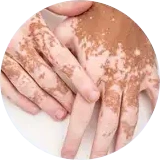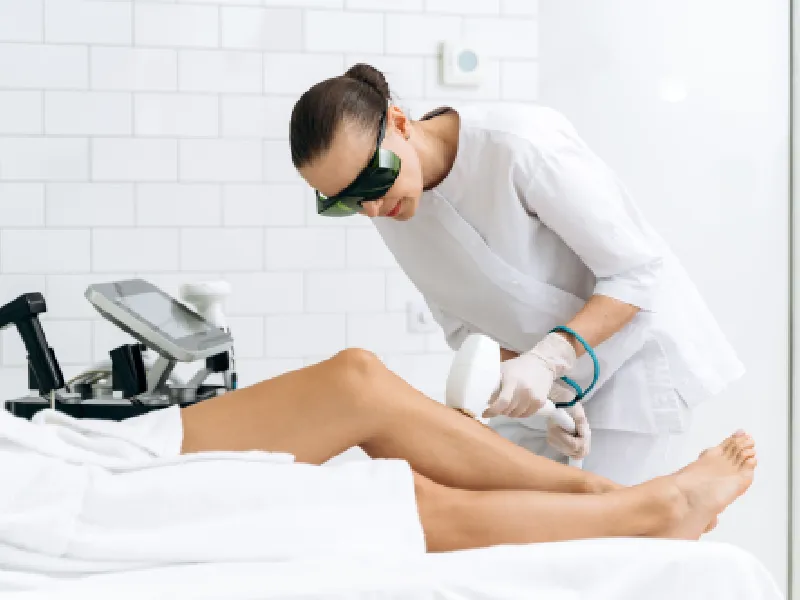- Date: Nov 18 2024
Are you distressed with noticeable, pale white patches on your skin? Sadly, you might be having vitiligo, There are different types of vitiligo that a licensed, knowledgeable, and experienced dermatologist and vitiligo doctor in Delhi can only identify and treat. If you suspect vitiligo, this article by Mehektagul Dermaclinic dermatologist is a must-read to learn about types of vitiligo disease and its symptoms as well as its causes, treatment, and management.
What is Vitiligo?
Vitiligo is primarily described as a skin condition characterized by loss of natural skin color/melanin pigment in macules or patches. These macules or patches appear lighter than the natural skin tone or sometimes look pale white. They can develop on the skin covering any site of the face and body. In some cases, vitiligo may affect hair turning them white, and mucous membranes like the mouth lining, genitals, nostrils, and within the ear canal.
The affected areas of discolored skin may prevail throughout one’s life, thus impacting one’s life quality, esteem, and confidence.
Causes of Vitiligo
Vitiligo is an outcome of non-functional or dead melanocytes that result in less melanin in the skin. Melanin is the colored pigment that imparts natural color to skin, hair, and mucous membranes. Melanocytes are specialized cells responsible for melanin production.
Vitiligo is mostly believed to be an autoimmune disorder wherein the immune cells become the killer of melanocytes. Sometimes, it is considered to be associated with the nervous system or be the result of a genetic mutation that affects melanocyte functioning.
Vitiligo may flare or spread to most parts of the body because of high emotional/physical stress, toxic chemical or UV radiation exposure, sunburn, cuts, or other damage to the skin. The condition is not biased to one’s gender, age, and ethnicity. People who are more likely to be affected with Vitiligo include those with a family history of vitiligo or autoimmune conditions, those having another autoimmune condition, or those suffering from melanoma/non-Hodgkin lymphoma.
Common Symptoms of Vitiligo
The signs of Vitiligo usually show up at any age, often, before the age of 20-30. Commonly reported symptoms include:
- Loss of skin color, starting from flat, pale white macules and gradually progressing to completely white or slightly pink patches with smooth or irregular edges.
- Loss of natural color of mucosal tissues lining the mouth and nose.
- Localized tuft of hair turning white.
The vitiligo patches appear in different patterns and may worsen over time. As the condition progresses, new patches form and existing ones grow larger. The larger patches usually stabilize. The number and size of the patches vary from one person to another.
Types of Vitiligo: A Comprehensive Guide
Classification of Vitiligo is based on the appearance of spots/patches, their spread, and their coverage on the skin. There are different types of vitiligo patches as elaborated below. You can get in touch with doctors at Mehektagul Dermaclinic to get more details on types of vitiligo with pictures.
 Non-Segmental Vitiligo (Generalized Vitiligo)
Non-Segmental Vitiligo (Generalized Vitiligo)
Non-segmental vitiligo features generalized vitiligo patches, and symmetrical white patches across the body. The white patches are commonly on either side of sun-exposed skin. It is the most common type with a spreading time slower than segmental vitiligo.
 Segmental Vitiligo
Segmental Vitiligo
Segmental vitiligo features localized vitiligo patches, and rapid loss of skin color that affects one side or segment of the body. It commonly occurs in children. The condition stabilizes and turns out to be less erratic than generalized vitiligo after 6-12 months and new white patches may stop developing.
 Focal Vitiligo (Localised Vitiligo)
Focal Vitiligo (Localised Vitiligo)
Focal vitiligo is limited to a small area of the body. These patches do not spread extensively.
 Mucosal Vitiligo
Mucosal Vitiligo
Mucosal vitiligo affects mucous membranes like the lips and genital areas.
 Acrofacial Vitiligo
Acrofacial Vitiligo
Acrofacial vitiligo primarily affects fingers, toes, and facial areas as well as hands, scalp, and around the genitals.
 Universal Vitiligo
Universal Vitiligo
Universal vitiligo is a widespread rare type of vitiligo that involves the depigmentation of almost the entire body.
How Dermatologists Help Identify the Type of Vitiligo You Have?
Dermatologists in Delhi will thoroughly examine the affected skin with and without Wood’s lamp and take note of the spread of patches; the spreading time; the onset of the condition; if stressed, injured, or exposed to toxins; any family history of autoimmune conditions; and if already tried any treatments. This way vitiligo is confirmed and diagnosed and even its type is identified.
Treatment Options for Various Types of Vitiligo
Various remedies can work to treat white patches on the face or elsewhere, Vitiligo treatment in Delhi at Mehektagul Derma Clinic offers the following treatment options:
- Medications- including calcineurin inhibitors, topical Janus kinase inhibitors, or corticosteroids.
- Phototherapy or laser therapy.
- Depigmentation therapy using state-of-the-art Q switched Nd Yag laser, strong chemicals like monobenzyl ether of hydroquinone (M-BEH), and phenol.
When to Consult with a doctor for vitiligo treatment?
If vitiligo is left untreated, the patient may be at risk of sunburns and extensive spreading of patches that impact life quality. So, it is advised to promptly go for vitiligo identification and treatment as soon as the symptoms appear. Confused, where to start? Request for a consultation with a top-notch Vitiligo Specialist in Delhi at Mehektagul Derma Clinic.
Tips for Managing Vitiligo
Living with Vitiligo is mentally and physically challenging. So, in addition to doctor-recommended treatments, managing vitiligo is advised. This includes following proper skin care for vitiligo, sun protection tips, and looking for vitiligo support groups.
Sun Protection and Skincare Tips
- The patient should protect the skin from direct sunlight by avoiding going outdoors during the daytime. If going out is necessary, the patient should wear suitable sunscreen and sun-protective clothing and if possible, seek shade. Sunscreen reapplication is a must every 2 hours after sweating or swimming for consistent UV protection.
- The patient should keep vitiligo-affected skin well moisturized with a gentle, fragrance-free, hypoallergenic moisturizer suitable to the skin type.
- The patient should regularly see a dermatologist for personalized advice on skincare with vitiligo and to monitor for progress of vitiligo.
Coping with Emotional and Social Challenges
Doctors advise finding a vitiligo support group in your place of living or through an online community. Reaching out to a qualified dermatologist to get a correct perspective of your condition and its prognosis will definitely help.
FAQs About Types of Vitiligo
Is Vitiligo Contagious?
No. Vitiligo is an autoimmune condition that is not transferable from an affected person to a healthy person.
Can Vitiligo Be Cured?
No. Vitiligo symptoms are treatable and manageable but can’t be permanently reversed. The existing vitiligo treatments focus on camouflaging pale white skin patches, skin pigmentation recovery, or acceptance to live with the condition.
How Do I Prevent Vitiligo from Spreading?
Vitiligo is a hypopigmentation disorder that cannot be prevented from occuring because of limited knowledge about its cause. However, dermatologists at Mehaktagul Dermaclinic advise prompt treatment to prevent its spread, and repigmentation while keeping the skin sun-protected to avoid remission or worsening of vitiligo patches.

K-105, Basement, Hauz Khas Enclave, New Delhi -110016



















